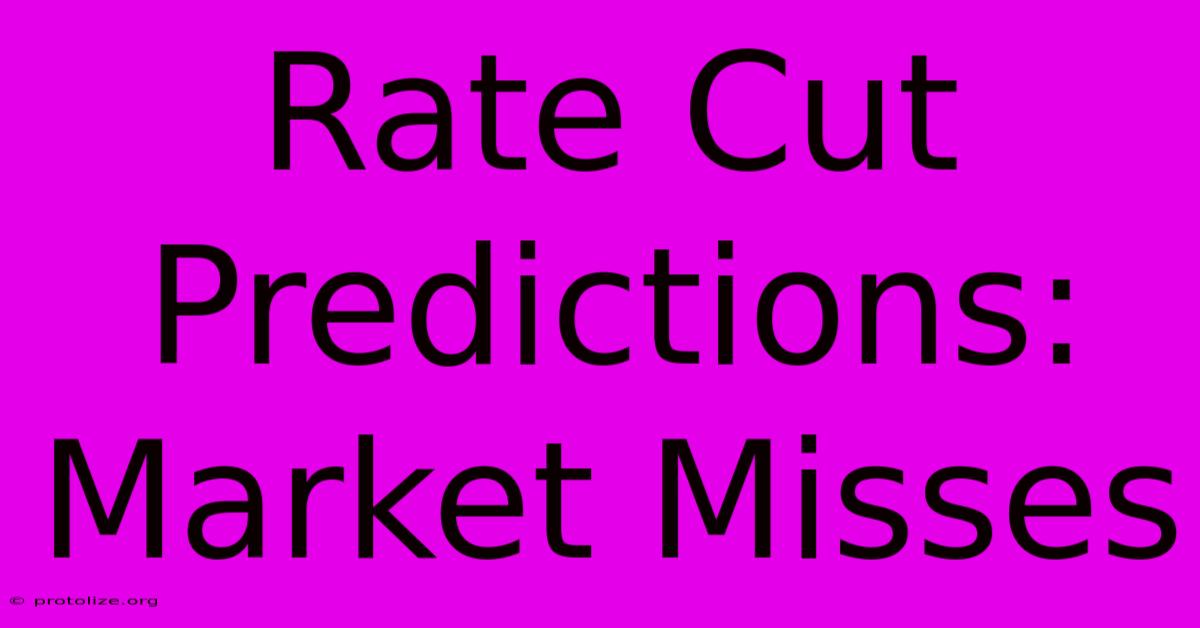Rate Cut Predictions: Market Misses

Discover more detailed and exciting information on our website. Click the link below to start your adventure: Visit Best Website mr.cleine.com. Don't miss out!
Table of Contents
Rate Cut Predictions: Market Misses - When Expectations Fail to Meet Reality
The financial markets are a complex dance of anticipation and reaction. Nowhere is this more evident than in the realm of interest rate predictions. When central banks hint at, or even explicitly signal, a rate cut, the market often reacts with enthusiasm. However, reality doesn't always align with expectations, leading to significant market misses and subsequent volatility. This article explores the reasons behind these discrepancies, examining the factors that contribute to inaccurate rate cut predictions and their impact on investors.
Why Rate Cut Predictions Often Miss the Mark
Predicting interest rate movements is notoriously difficult, even for seasoned economists. Several factors contribute to these prediction misses:
1. Uncertain Economic Data:
Economic data, the cornerstone of rate-setting decisions, is often subject to revision and unexpected fluctuations. Employment figures, inflation reports, and GDP growth estimates can be volatile, making it challenging to accurately forecast future economic trends. A seemingly strong employment report might mask underlying weakness, leading to inaccurate rate cut expectations.
2. Geopolitical Uncertainty:
Global events, from political instability to international conflicts, significantly influence economic conditions and central bank decisions. Unexpected geopolitical shocks can disrupt established economic forecasts, rendering earlier rate cut predictions obsolete. The invasion of Ukraine, for example, drastically altered global energy markets and inflation projections, impacting central bank strategies.
3. Central Bank Communication Challenges:
Central banks often employ nuanced language when communicating their intentions, leaving room for interpretation and differing opinions. Ambiguous statements can lead to varied interpretations of the likelihood and timing of a rate cut, contributing to inaccurate market predictions. The "forward guidance" provided by central banks is crucial but can be difficult to decipher accurately.
4. Market Sentiment and Speculation:
Market sentiment, driven by investor psychology and speculation, can significantly impact rate cut predictions. Excessive optimism or pessimism can lead to over- or underestimation of the likelihood of a rate cut, even if fundamental economic indicators remain relatively unchanged. This can create a self-fulfilling prophecy, where market expectations influence the actual outcome.
5. Unexpected Inflationary Pressures:
Inflation is a major factor influencing central bank decisions. Unexpected spikes in inflation can force central banks to deviate from their planned rate cut trajectory, leaving markets surprised and potentially leading to significant losses for investors who anticipated a rate reduction. Persistent inflation, resistant to typical monetary policy tools, is a particular challenge.
The Impact of Missed Rate Cut Predictions
Market misses on rate cut predictions can have far-reaching consequences:
Increased Market Volatility:
When the market's expectations diverge from central bank actions, it can trigger significant market volatility. Sudden changes in interest rates affect asset prices, impacting stocks, bonds, and other investment instruments. This volatility can create uncertainty and loss for investors.
Impact on Investment Strategies:
Inaccurate rate cut predictions can disrupt investment strategies, forcing investors to re-evaluate their portfolios and adjust their risk exposure. Investors who based their investment decisions on anticipated rate cuts might find their strategies undermined, leading to potential losses.
Currency Fluctuations:
Interest rate decisions heavily influence currency exchange rates. Missed rate cut predictions can result in unexpected currency fluctuations, impacting international trade and investment flows.
Conclusion: Navigating the Uncertainty
Predicting interest rate cuts remains a complex and challenging task. While economic forecasting models provide valuable insights, they are not foolproof. Investors should recognize the inherent uncertainty involved and adopt a diversified investment approach that accounts for the potential for unexpected outcomes. Staying informed about economic indicators, geopolitical developments, and central bank communications is crucial for navigating the unpredictable nature of interest rate movements. Careful risk management and a long-term investment perspective are paramount in mitigating the impact of missed rate cut predictions.

Thank you for visiting our website wich cover about Rate Cut Predictions: Market Misses. We hope the information provided has been useful to you. Feel free to contact us if you have any questions or need further assistance. See you next time and dont miss to bookmark.
Featured Posts
-
Crm Strategy Consultant
Dec 09, 2024
-
Acf Fiorentina Vs Cagliari Picks
Dec 09, 2024
-
Coleen Rooney Vardys Exs Angry Response
Dec 09, 2024
-
Tottenham Vs Chelsea Live Premier League Match
Dec 09, 2024
-
New Tesla Self Driving Car In Texas
Dec 09, 2024
